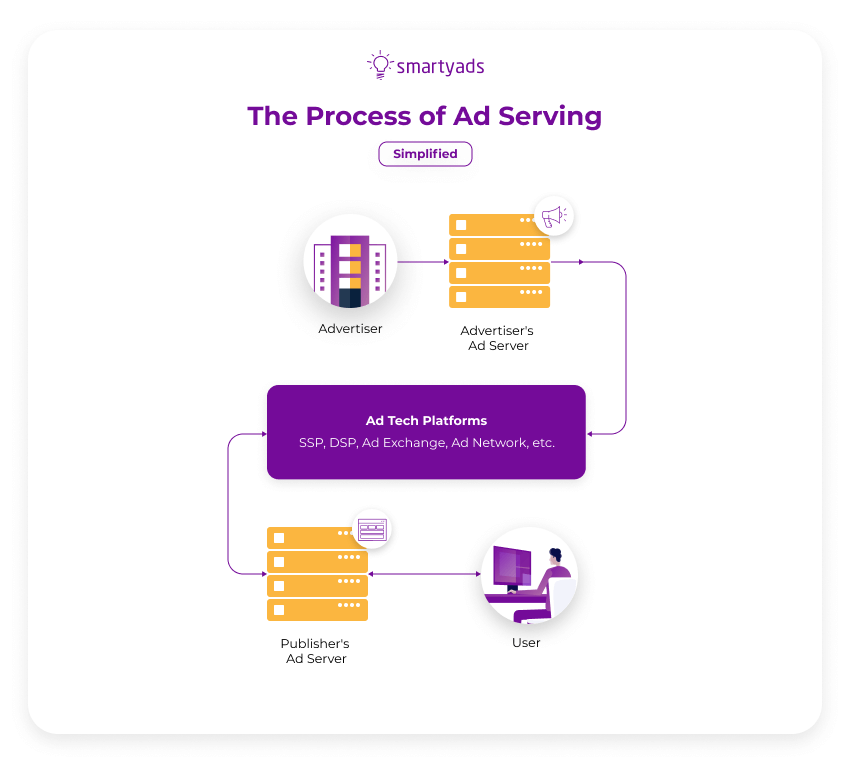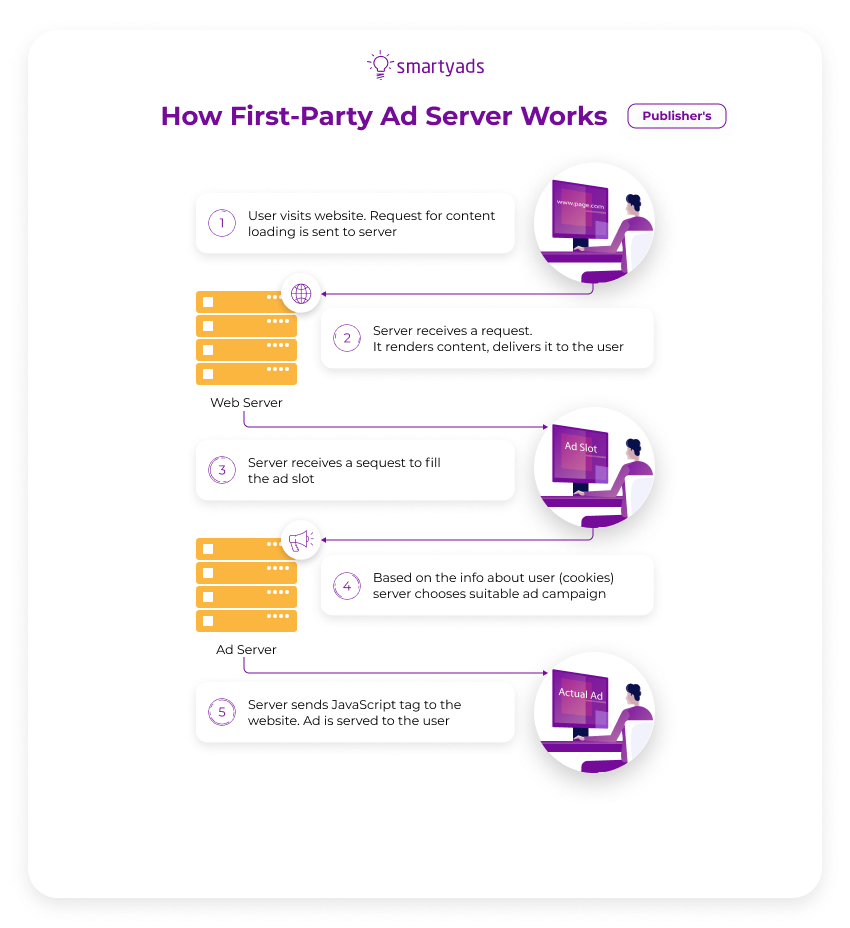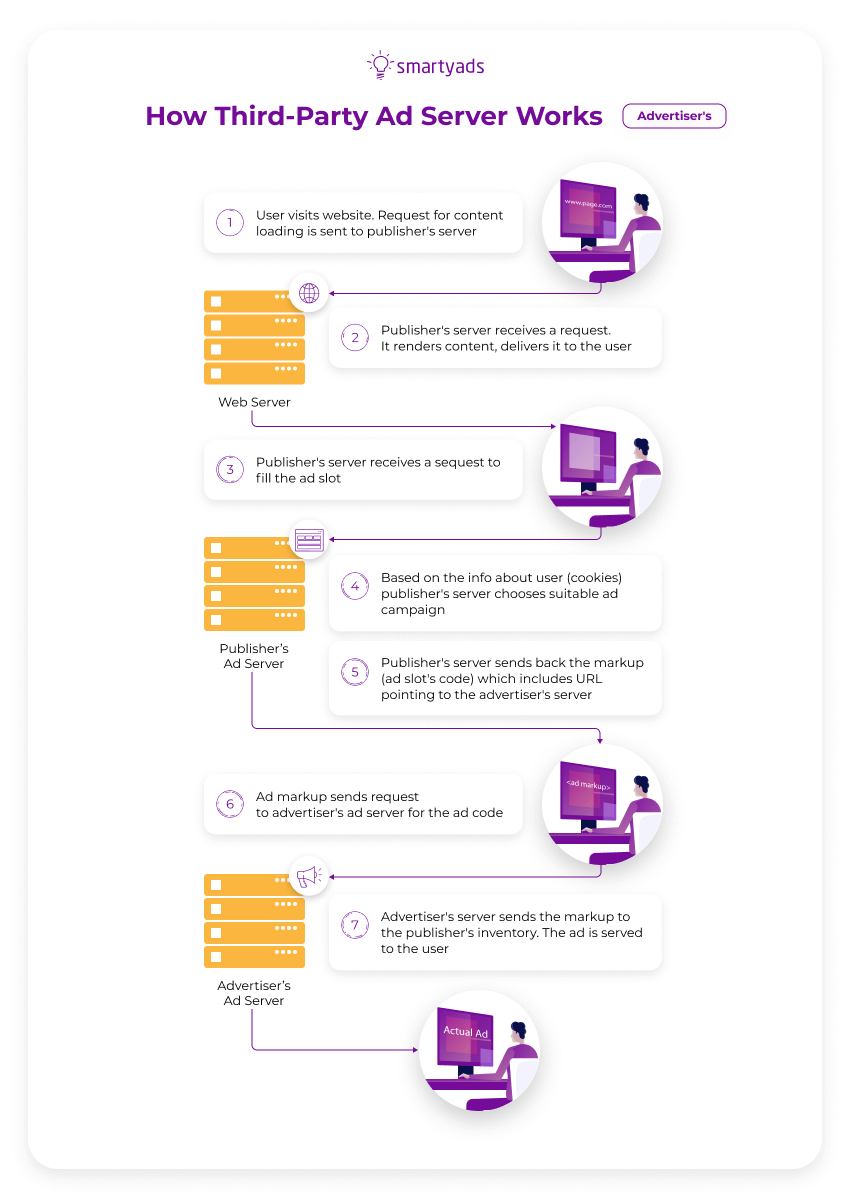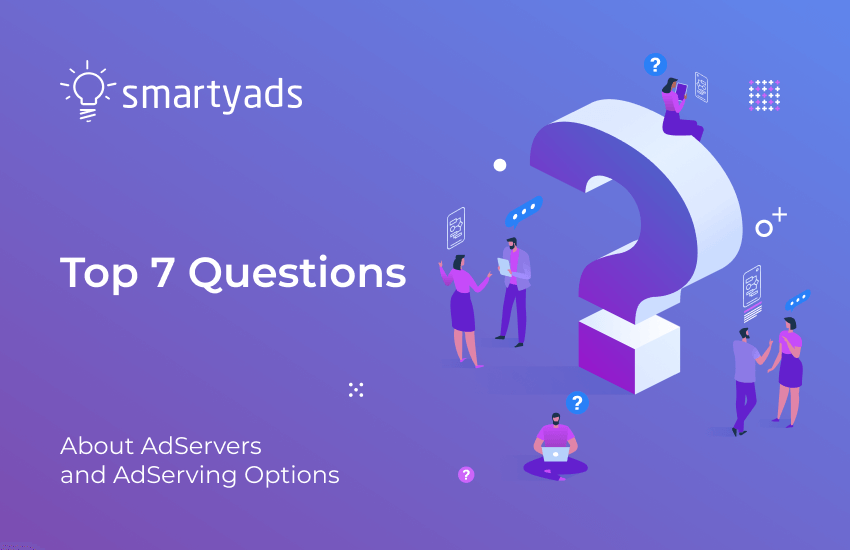The programmatic ecosystem is a complex network of players, each with their unique role in the online advertising industry. From demand-side platforms (DSPs) to supply-side platforms (SSPs) and ad exchanges, these components work together to create an efficient and effective advertising system. In addition to these, ad servers are a vital element in popular ad tech systems and platforms, powering programmatic ad networks.
Ad-serving technology plays a vital role in digital advertising. Advertisers and publishers must understand the importance of ad servers and their role in programmatic advertising. That's why we've compiled a list of the top 7 frequently asked questions to help you navigate this exciting industry. Let's get started!

What is an ad server?
Publisher Ad Server
Publisher ad servers are online systems that host, optimize, and distribute advertising content across various ad-serving platforms. They form the foundation for managing ad campaigns, tracking performance, and generating revenue for publishers.
Advertiser Ad Server
Advertiser ad servers, also known as campaign management platforms or ad tracking systems, are essential tools in online marketing and programmatic advertising. They play a crucial role in hosting and delivering advertising content to targeted audiences across websites, social media platforms, and mobile apps.
What is ad serving?
How does an ad server work? Ad-serving meaning refers to the technology cycle that utilizes software to place advertisements on different websites. It can be used either by a demand-side platform, supply-side platform, ad exchange, or an ad network. An ad-serving engine is the core element of every ad server. It utilizes complex algorithms and advanced decision-making tools to select the most relevant ads for display.
The ad selection process is strictly restrained by the rules that are defined by advertisers and publishers and the ad server itself. These rules include such settings as targeting criteria, the frequency of ad viewing, ad priority, ad placement, digital ad format, earning potential, and more. Ad servers are also responsible for ad tracking, ad management, ad reporting, and ad billing.

Is there some classification for ad servers?
In the realm of advertising, there exist two types of ad servers: first-party and third-party. These diverse ad-serving technologies are utilized by both publishers and advertisers alike. First-party servers enable publishers to regulate their inventory and improve the delivery of ads.
Conversely, third-party servers are utilized by advertisers to optimize their creatives across all their campaigns. These servers are critical in overall campaign optimization and reporting.
Self and managed serve options. Servers can be either self-serve or managed. Self-serve servers are installed and maintained by their owners, while managed servers are run by third-party vendors.
Self-serve servers offer a wider range of functions because their scripts can be modified and customized as needed. However, they require a significant amount of human resources, constant monitoring, and maintenance in order to function smoothly and stably.
Local and remote types. An ad server definition says can be located either locally or remotely. A local ad server is one that you can physically access since it is owned by the publishers themselves. Additionally, you can also make use of a third-party company that provides remote server access.
On the other hand, remote ad servers are managed independently and can serve multiple publishers. They operate from a single source, which enables advertisers to track the placement of ads throughout the Internet.
It should be said that an ad server is suitable for big companies that require large capacity for their advertising campaigns. If you just want more control over your advertising, self-serve advertising might be a better choice for you.
The story of the first ad server
The first ad server, FocaLink Media Services, emerged in 1995 to help publishers schedule and fill ad slots. Later renamed AdKnowledge, the company was acquired by ModusLink Global Solutions and eventually by a company in Kansas City that still operates under the AdKnowledge brand.
At the time, personalizing ads was challenging, and the header information was the only way to organize targeted display or video ad serving. The browser could only pass information about the PC’s language, browser configuration, OS and the webpage that the user loaded. In January 1996, NetGravity released the first local ad server to serve ads from major publishers such as Yahoo and Pathfinder.
NetGravity went public in 1998 and was acquired a year later by DoubleClick for publishers DFP, which renamed the NetGravity ad server DART. In March 2008, DoubleClick was purchased by Google.
Today, ad servers can handle a wide range of ad formats and provide advanced targeting capabilities. They can also track ad performance and provide detailed analytics to help advertisers optimize their campaigns. As such, ad servers have become an essential tool for online advertising.
How do third and first party ad servers work?
Ad-serving technology is a bit complex and involves many steps. Everything starts when a user visits a website or app. From there, an IP connection between the user’s computer and the publisher’s web server is established. The website begins to load. Meanwhile, ad tags on the site load, too, and call the sell-side ad server.
↓
An ad server can quickly gather useful information about a user, including location, language, online activity, age, gender, marital and employment status. With the help of a data management platform, this information is easily accessible to deliver the right message to the right person at the right time.
↓
Then, the ad server sends requests to ad exchanges, where buyers bid on it if they are interested in the ad space and find the user-relevant.
↓
Ad servers also check how many times the potential ad was shown to this particular user in the past, called frequency capping. If the ad was shown too often, it is rejected.
↓
A publisher’s ad server processes millions of buyer requests and chooses the best-paying ad in milliseconds. Then it redirects the browser to the marketer’s ad server and fetches the ad creative from the content delivery network (CDN).
↓
Finally, the ad is retrieved and successfully downloaded on the web page. This counts as an impression. Regardless of the number of calls, the user’s browser organizes the whole process of online advertising: ad selecting, and ad placing must not take longer than a second to guarantee high viewability.
↓
Thus, we’ve described in general terms how the advertising process is organized by the ad servers. However, if you want to plunge deep and sort every step of how it happens on the publisher and advertiser side, in the picture below ,you can see the difference between the work of the first-party (publisher) ad servers and third-party (advertiser) ad servers.
What is a publisher ad server?
Ad servers used in programmatic buying can be categorized into two types: sell-side first-party ad servers and advertiser third-party ad servers. Although both platforms use similar technology, they perform different functions. Publishers use sell-side first-party ad servers to run creatives with various targeting and technical requirements across multiple formats.
The ad-serving interface makes it easy for digital media sellers to add new buyers to their contact lists and stay organized by editing, managing, and deleting partners. Additionally, publishers can obtain independent reports about ad creatives, discover the best performing digital ad formats, and optimize their ad space on time.
Leveraging publisher ad servers (first party ad server) media-sellers can:
- Optimize and enhance the value of ad inventory and ad impressions.
- Control how users interact with all kinds of multi cross platform ad units: banner ads, mobile ads, video ads, rich media ads, etc.
- Provide additional information about ad inventory and generating ad revenue.
- Collect statistics regarding the number of impressions, clicks, measure the performance regarding suitable metric, and provide attribution (per month/week/day, etc).

What is an advertiser ad server?
What is the goal of the ad-serving model? The functions of the third party ad server ultimately aim to accomplish two main tasks: storing and managing the ad code, as well as configuring the tracking options for advertising campaigns.
An ad server is a platform used by advertisers to manage their online advertising campaigns. Third party ad servers, specifically designed for media buyers, help advertisers to achieve maximum profits for minimum ad serving costs.
They centralize the ad buying process across a variety of publishers, allowing advertisers to track metrics such as impressions, clicks, conversions, and purchases in one place. This helps advertisers to optimize their campaigns and make data-driven decisions.

Functions of the third party ad server boil down to:
- Storing and managing the ad code
- Configuring the tracking options for advertising campaigns
- Tracking the results of the ad campaigns (in the number of clicks, actions or impressions)
- Checking the reach of the ad campaign
- Matching the data with reports from publishers
- Optimization of the different ad campaigns

What are the features of an ad server?
Most of the ad servers offer a mixture of ad delivery and ad management features for advertisers and publishers (ad networks usually include those). Others have limited offers. When choosing an ad server, make sure it includes the following features:
Ad creative upload
Supports all standard creative sizes and IAB (Interactive advertising bureau) formats, such as text, image, video, animation, audio, games, interactive, native, rich media, in-app, mobile, and others.
Campaign scheduling
Determines the dates by which the campaign has to run.
Automatic optimization
Chooses the best-performing ads and serves more of those.
Delivery speed
Determines how often impressions are delivered (evenly or as fast as possible). Location-based targeting: Targets by country, state, province, metro area, city, zip code, language.
Technical targeting
Delivers ads to the web, mobile, tablet, or TV screens and offers various operating systems and cross-device targeting.
Time targeting
Schedules ads to a specific time of the day when users are most active. Social and demographic targeting: Focuses on age, language, gender, nationality, income, employment status, etc.
Behavioral targeting
Target consumers by their online behavior, search history, and interests.
Retargeting
Analyzes consumer engagement with the brand in the past and displays the online ad to draw more attention and trigger more interaction such as clicking, subscribing, and purchasing.
SEO
Allows bidding on keywords and ensures ads appear on search engine results pages.
Creative sequencing
Allows setting a specific order for ads to appear, usually under the same creative concept.
Frequency capping
Controls online ad serving - how many times the ad is shown to the same user and limits it to the number of impressions per hour, day, or a specified period.
Ad tracking
Monitors whether the creative content is generating desired results and the proper traffic of ads happens and guarantees the advertising content is shown in front of intended demographics in the correct time and place.
Reporting
Offers real-time, dashboard, notification alert, custom reports and provides granular reports on clicks, impressions, costs, ROI, and eCPI.
Challenges and Solutions
Ad Fraud
Ad fraud poses a significant threat to the integrity of digital advertising by siphoning billions of dollars annually from advertisers. Ad servers play a crucial role in combating ad fraud through various measures. They employ sophisticated algorithms and machine learning techniques to detect fraudulent activities such as click fraud, impression fraud, and bot traffic.
Ad servers also implement strict verification processes to ensure that ads are displayed to real human users in appropriate contexts. By continuously monitoring and analyzing ad performance metrics, ad servers can identify irregular patterns indicative of fraudulent behavior and take proactive steps to mitigate risks.
Ad Blocking
The proliferation of ad blockers poses a significant challenge to the ad server ecosystem, as it undermines the effectiveness of digital advertising campaigns and diminishes revenue opportunities for publishers. Ad servers deploy various strategies to address this challenge, including developing non-intrusive ad formats, improving ad relevance and targeting, and partnering with anti-ad-blocking solutions.
By focusing on delivering a positive user experience and respecting users' preferences, ad servers can mitigate the impact of ad blockers and ensure that ads reach their intended audience.
Other Challenges
Beyond ad fraud and ad blocking, ad servers face additional challenges in the dynamic digital advertising landscape. These include issues such as ad viewability, brand safety, ad verification, and ad delivery optimization. Ad servers address these challenges by leveraging advanced technologies such as artificial intelligence, predictive analytics, and real-time bidding algorithms.
By providing robust solutions for targeting, tracking, and optimizing ad campaigns, ad servers empower advertisers and publishers to overcome these challenges effectively.
How do you choose an ad server?
For starters, you need to determine what tasks you need the ad server for. Essentially, the first and the third party servers are the same pieces of technology. However, they are used by publishers and advertisers differently because the demand and supply sides have different challenges and needs. As soon as you determine your core tasks it’s time to match them to specific functions of the platform. Assess every option from the standpoint of functionality they provide and whether those will be sufficient to satisfy your needs.
What’s also important, technically all servers can be categorized as self hosted and managed. Those two can work fine, but if the managed one is maintained by the tech provider, the maintenance and configuration of the self hosted (self serve) depends on you. In case your company has employees that have expertise and experience in dealing with such technologies, self serve one can be an option that saves a substantial part of your budget. Without knowledge, skills, and professionals in staff, it is recommended to opt for the managed one.
The comparison between self serve and managed ad server
Self serve servers Managed servers Upsides
- Scripts can be modified and adjusted according to the needs of a particular company. For this, the company needs front-end and back-end developers on staff.
- The script is usually very affordable or free of charge.
- With good tech professionals onboard you get more control over data protection and security.
- No need to have specialized knowledge. Managed servers usually have user-friendly and intuitive interfaces.
- No deployment needed.
- The updates and improvements are carried out by the tech vendor’s team.
- User support assists users and helps to sort out problems (if any).
- The performance of the server is constantly monitored.
Downsides
- Substantial human resources (needed to deploy the server and maintain it).
- Employees need to have sufficient experience and expertise with ad servers.
- Tech updates should be done regularly.
- The price is higher when compared to the self serve option.
- The script customization isn’t possible.
- The data is stored by the third party provider technology so you have less control over it.
No need to buy the best ad technology separately and go through the annoying integration across multiple providers. For example, SSPs and DSPs go along with integrated ad servers. Technology from the same vendor is guaranteed to run seamlessly and work together cohesively.
Examples of ad servers that are available as a part of inexpensive solutions are free, open-source ad servers. They offer basic functionalities and are highly customizable. Some ad server examples include DFP Small Business, Orbit Open Ad Server, and Revive Adserver.
What is a mobile ad server? Mobile ad servers offer to target mobile-based criteria, such as device, ad server software, mobile carrier, operating system, connection type, screen size, and more. Mobile ad servers could be a part of a mobile real-time bidding framework for buyers and sellers: mobile DSPs/SSPs and mobile ad exchanges.
What is the cost of an ad server?
Ad server costs can vary depending on functionalities, provider,s and other characteristics. For Google Ad Manager users servers are free of charge (up to the certain threshold of served impressions), precisely, 90 million impressions for certain geos. After this, the customers get charged for impressions that come from non-AdSense networks.
The smarter an ad server is, the more expensive the installation and maintenance will be, as it takes more work and resources to keep it functioning.
Apart from this, such solutions usually offer a sufficient degree of control over ad operations: storage of creatives, optimizing ad campaigns, filtering, tracking, targeting, reporting, and the rest of the functions advertisers and publishers access on the platform. The interfaces of these programmatic tools are exceptionally user-friendly and suit people with no specific technical background.
To wrap it up
Ad servers are deeply integrated into the ad tech ecosystem so everyone who wants to run ad campaigns or monetize their inventory effectively can access such capabilities using ad monetization solutions and programmatic media buying tools.
Choose your programmatic advertising platform to advertise and monetize effectively!
FAQ
An ad server is a type of server used to store and deliver online advertisements to websites, apps, and other types of ad inventory. Ad server hosts creatives and optimizes campaigns, organizes targeting, distributes ad content, and performs a set of important tasks for publishers and advertisers.
Such a process is complex and multilayered, it includes a selection of the creatives, matching the targeting criteria with data in cookies, analyzing campaign settings, organizing campaign tracking, reporting, management, and other operations.
Servers can be classified according to several criteria: purpose, maintenance, and location. Purpose: there are first party servers created for publishers and third party servers created for advertisers. Maintenance: self and managed serve servers. Location: local servers and remote servers.
Support for various creatives, ad campaigns automation (scheduling, optimization, speedy delivery). Strong cross channel and cross device targeting, retargeting functionality). Creative allocation, frequency capping, tracking of the creatives with tags, etc., and performance reporting.
When a user visits a webpage, the publisher's website sends a request to the ad server. The ad server evaluates targeting criteria and selects the most relevant ad from its inventory. It then delivers the ad to the user's browser, where it is rendered alongside the webpage content, completing the process of serving the display ad.





